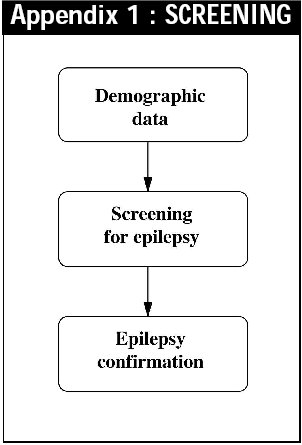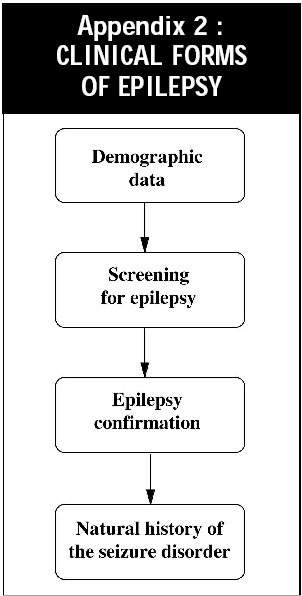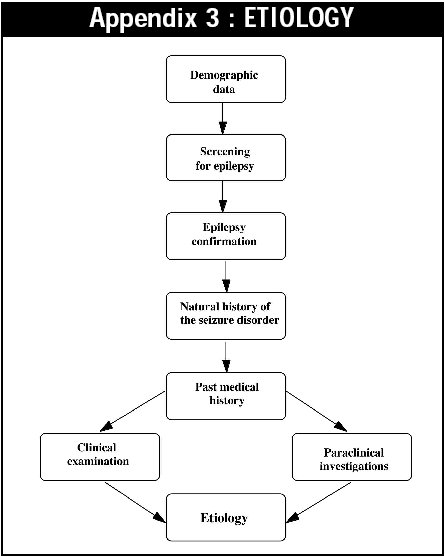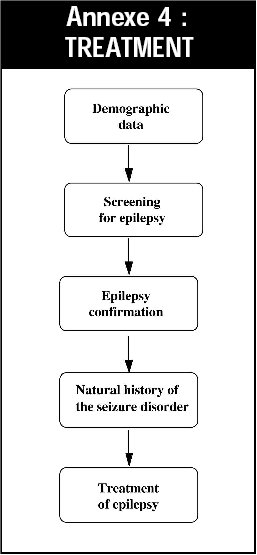NEUROEPIDEMIOLOGY / NEUROEPIDEMIOLOGIE
QUESTIONNAIRE FOR INVESTIGATION OF EPILEPSY IN TROPICAL COUNTRIES
E-Mail Contact - QUESTIONNAIRE FOR INVESTIGATION OF EPILEPSY IN TROPICAL COUNTRIES :
I – Introduction
The purpose of this questionnaire is to standardize information on the epilepsy studies. It was developed through collaborative work involving the Institute of Neurological Epidemiology and Tropical Neurology of Limoges (France), the Pan-African Association of Neurological Sciences and the International League Against Epilepsy (Commission on Tropical Diseases, 1993-1997).
II – Objectives
This questionnaire will be widely used in various tropical and subtropical regions. It was developed in a modular structure and comprises nine sections : demographic data, screening, confirmation of diagnosis, natural history of the seizure disorder, past medical history, clinical examination, paraclinical examinations, etiology, treatment. It investigates 4 different objectives:

II – 1 – Screening (appendix 1) :

II – 2 – Clinical forms of epilepsy (appendix 2) :

II – 3 – Etiology (appendix 3) :

II – 4 – Treatment (appendix 4) :
III – How to use the questionnaire
The open brackets must be filled with the codes indicated in the questionnaire. The other questions must be answered in text language and will be coded later in the right column. This method allows to investigate with more freedom and greater accuracy. When the asked question needs a quantitative answer and this answer is not known, then the investigator should let the brackets empty.
The code of each individual is at the top of each page. The first 3 spaces are meant for the code of the country. To keep the study homogeneous, the codes could be given to the main investigator of the particular study, by the Institute of Tropical Neurology of Limoges; the next 2 spaces are meant for the year of the study, the 2 following spaces for the region and the last 4 spaces for the identification of each subject. Through this system, various studies can be carried out in the same country or in different countries (up to 9999 subjects), and remain confidential as the identification section can be separated from other sections. For example, the code of the first subject of a study carried out in 1996 in the Atacora region in Benin could be BEN-96-AT-0001.
III – 1 – Demographic data
This provides the means to localize a specific subject (the address should be quoted very precisely), the professional activity and the period of stay in the study region. For the question D17, the definition of the rural-urban environment may change depending on the region of the study: the usual definition in France takes the threshold at 2 000 inhabitants. Although this may not perfectly apply, we propose to use this definition. Depending on the situation this definition may however be modified.
The data storage system used follows the ethical requirements of confidentiality and is quite safe. The questions concerning ethnic groups and religion are not compulsory.
III – 2 – Screening
This can be filled by a non medical investigator. However, it is important that all field-investigators should be trained and have a working knowledge of the different seizure types. If one of the answers is positive, the investigator must go on filling in the questionnaire and the subject must be examined by a physician to confirm the epileptic nature of the attack(s).
III – 3 – Confirmation
This section must be filled in by a physician to confirm the diagnosis of epilepsy. The clinical description of the attack(s) should be precised (foaming at the mouth, loss of bladder control, movements …). If not, the physician can state if the attack(s) occurred in a particular situation, as part of an ongoing disease, or if the attack was an isolated seizure. If epilepsy is confirmed, the questionnaire must be continued.
III – 4 – Natural history of the seizure disorder
This section should allow the possibility to describe the variety and the age of the epileptic seizures of the study subject. The question N1 looks for active epilepsy i.e. a subject who has had at least one seizure within the last 5 years, whatever treatment he may have had. The official document of the International League Against Epilepsy which classifies the definition of active epilepsy, the different classifications of seizures, as well as the guidelines for epidemiological studies is to be found in the appendix.
III – 5 – Past medical history
The questions concern the family history of epilepsy, and the personal history with an emphasis on the pregnancy history of the subject’s mother, birth and psychomotor development, infantile diseases and neurological sequaelae due to these diseases and the period before the appearance of this sequaelae.
The siblings are defined as brothers and sisters of the same mother to the subject. The consanguinity relations and past family histories should strictly be looked for in the same family.
A pregnancy should be considered abnormal if the mother had haemorrhages, hypertensive attacks, premature uterine contractions, threatened abortion. Labour should be considered as prolonged if its goes beyond 12 hours for a primigravida and 6 hours for a multigravida.
An infant is considered as premature in this questionnaire if the mother gave birth before the 35th week of amenorrhea. The psychomotor development should be assessed against the age of acquiring different milestones e.g. sitting, walking, language etc.
Measles is considered as severe if the subject developed neurological or pulmonary complications. Encephalitis is diagnosed if there is impairment of conciousness, presence of local neurological signs and fever. Encephalopathy presents with alterations of consciousness and neurological abnormalities. Meningitis is characterized by meningeal syndrome associated with fever. Coma beyond 24 hours is considered prolonged. For the questions P47 to P49, one needs to find out if the subject works with animals, professionally or in his daily life, or if the animals live in his house. Excessive alcohol consumption is defined as daily ingestion of 300 ml or more of pure alcohol in females and 400 ml or more in males. All persons who use illegal toxic materials, natural or synthetic chemicals that may cause physical and / or psychological dependency are considered as drug addicts.
III – 6 – Clinical examination
The general state of health of the subject must be assessed by investigator and is defined as: poor if there is a loss of weight with asthenia, and difficulties in daily activities, average if there is asthenia or loss of weight but no problem in daily activities, good if there is no weight loss and no asthenia.
Intelligence Quotient is used to judge mental retardation of subjects. The following is the exact definition; mild mental retardation when the IQ is between 70 and 90, moderate mental retardation when IQ is between 50 and 70 and severe mental retardation when IQ is below 50. The IQ system is not however indispensable and the doctor should do a global evaluation of retardation.
III – 7 – Paraclinical examinations
is relatively complex and optional: it should not restrict the use of the questionnaire. This section has 5 parts: blood investigations, neuro-imaging techniques, electroencephalography, serologies and microbiology.
All paraclinical examinations that are possible to do, should be given a code as they may shed more light on the search of the etiology.
III – 8 – Etiology
This section searches the cause of the epilepsy and classify the seizure disorder in :
– Idiopathic (which corresponds to a classical syndrome, identified by an electrophysiological and clinical arguments, with often a strong genetic component),
– Symptomatic (of a previous disease, old lesions with no evolution; of an on-going disease),
– Cryptogenic (epilepsy which can not be classified as symptomatic or idiopathic and does not belong to the syndromes which have a strong genetic component).
III – 9 – Treatment
Classical or traditional medical treatment used by the patient is recorded. An evaluation of the efficacy of the treatment is carried out.